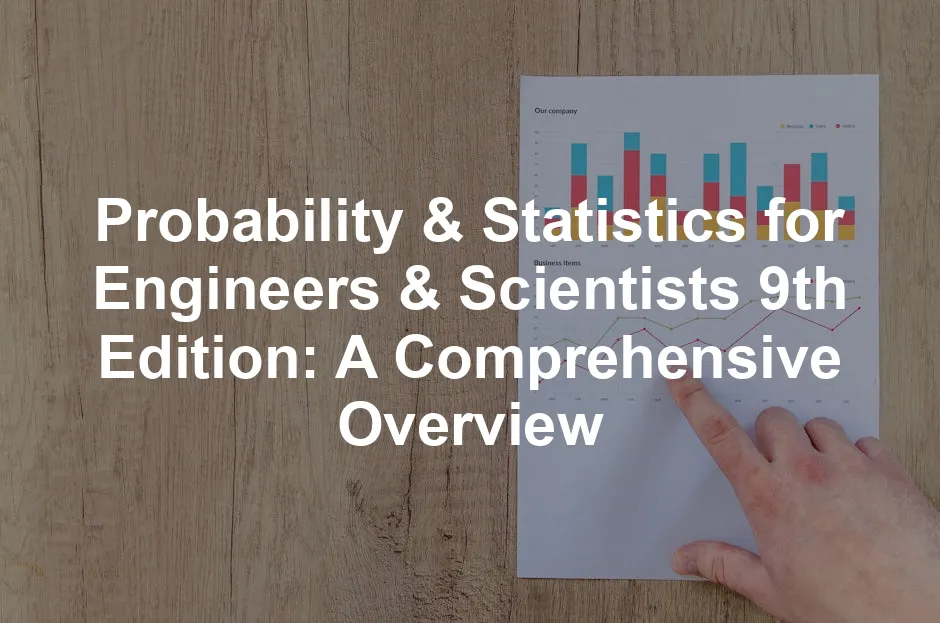Introduction
Probability and statistics play a vital role in engineering and scientific applications. They help professionals make informed decisions based on data analysis. Engineers depend on these tools to solve complex problems, while scientists utilize them to validate hypotheses and analyze research findings. Understanding these concepts can significantly enhance the accuracy and reliability of outcomes in various fields.
The 9th edition of “Probability & Statistics for Engineers & Scientists” by Ronald E. Walpole and his co-authors is a comprehensive resource tailored for students and professionals alike. This edition builds upon previous versions, incorporating updated examples and expanded content to meet the demands of modern engineering and scientific practices. For those looking to expand their knowledge, this book is a great starting point. You can check it out here: Probability & Statistics for Engineers & Scientists, 9th Edition by Ronald E. Walpole.
Readers can expect to find a balanced approach to theory and application. The book emphasizes real-world scenarios, ensuring that learners grasp how statistical methods apply to everyday engineering challenges. Throughout this article, we’ll unpack the key features of this edition, explore the authors’ backgrounds, and highlight what makes this textbook a must-have for anyone serious about mastering probability and statistics for engineering and the sciences.

This textbook is an essential resource for anyone looking to deepen their understanding of probability and statistics in engineering and science. probability and statistics for engineering and the sciences
Understanding the Book
Overview of the Authors
The authors behind this essential textbook are Ronald E. Walpole, Raymond H. Myers, Sharon L. Myers, and Keying E. Ye. Together, they bring a wealth of knowledge and experience to the table.
Ronald E. Walpole is a renowned statistician with a distinguished academic career. He has contributed significantly to the field of statistics, particularly in engineering applications. Raymond H. Myers, also a prominent figure, focuses on statistical theory and methodology. Sharon L. Myers and Keying E. Ye complement their expertise with their insights into statistical applications and educational practices.
This collaborative effort results in a textbook that is not only informative but also engaging and approachable. Their combined expertise ensures that readers receive accurate, relevant, and practical information throughout the book.
Edition Details
The 9th edition holds particular significance in the realm of engineering and statistical education. It reflects the authors’ commitment to enhancing the learning experience by incorporating feedback from previous editions. This revised version features updated examples, clearer explanations, and additional exercises to reinforce understanding.
The ISBN for this edition is 978-0321629111 for hardcover, and the publication date is April 22, 2021. This edition is also available in multiple formats, including eTextbook and paperback, catering to diverse learning preferences. Each format retains the same core content, making it accessible for students using various learning methods.
In summary, the 9th edition of “Probability & Statistics for Engineers & Scientists” serves as a vital academic resource. It combines the authors’ expertise with practical applications, ensuring students can apply statistical concepts effectively in their fields. Whether you’re an aspiring engineer or a seasoned scientist, this textbook is designed to enhance your understanding of probability and statistics, providing you with the skills needed to tackle real-world challenges.

Content Structure
The 9th edition of “Probability & Statistics for Engineers & Scientists” presents a well-organized and comprehensive table of contents. This structure guides readers through a logical progression of statistical concepts, ensuring a smooth learning experience. Here’s a detailed breakdown of the main topics covered in the book:
- Introduction to Statistics and Data Analysis
- Overview of statistical inference, samples, populations, and the role of probability.
- Discussion on sampling procedures and data collection methods.
- Probability Concepts
- Definition of probability, sample space, and events.
- Key probability rules: additive and multiplicative rules, conditional probability, and Bayes’ Rule.
- Random Variables and Probability Distributions
- Explanation of random variables and the distinction between discrete and continuous distributions.
- Deep dive into common distributions like Binomial, Poisson, and Normal.
- Statistical Inference
- Estimation problems and hypothesis testing, including one-sample and two-sample tests.
- Regression and Correlation
- Principles of simple and multiple linear regression.
- Importance of correlation in data analysis.
- Advanced Topics
- Nonparametric statistics, Bayesian statistics, and statistical quality control.
- Real-world applications and case studies.
This table of contents not only highlights the key areas of focus but also demonstrates how the material progresses from foundational concepts to more advanced topics. It begins with basic statistical principles and gradually introduces more complex ideas, ensuring that students build a solid understanding before tackling intricate applications. This logical flow is essential for engineers and scientists who need to apply these concepts in real-world scenarios.

Key Topics Covered in the Book
Introduction to Statistics and Data Analysis
Statistics isn’t just about numbers; it’s about making sense of those numbers. In this section, readers are introduced to fundamental concepts such as statistical inference, samples, and populations. The role of probability is emphasized, helping students understand why it’s crucial in data analysis.
Statistical inference refers to the process of drawing conclusions about a population based on a sample. To do this effectively, one must grasp the distinction between a sample—a subset of the population—and the entire population itself. The book delves into various sampling procedures, such as random sampling, stratified sampling, and systematic sampling, to illustrate how to collect data efficiently. It also covers the importance of data collection methods, ensuring that students appreciate how the quality of data impacts statistical analysis.

Probability Concepts
Probability is the bedrock of statistics. This chapter defines critical terms like probability, sample space, and events. Readers learn about the fundamental rules of probability that govern how events interact. For instance, the additive rule helps determine the probability of either of two events occurring, while the multiplicative rule is essential for independent events.
Conditional probability is another key topic. It addresses the likelihood of an event occurring given that another event has already occurred. This concept is vital in various applications, from risk assessment to decision-making in engineering projects. The chapter also introduces Bayes’ Rule, which allows for the updating of probabilities as new information becomes available. This is particularly useful in fields like machine learning and predictive analytics. For those looking to dive deeper into Bayesian methods, consider checking out Bayesian Data Analysis by Andrew Gelman.
Random Variables and Probability Distributions
Random variables are crucial for modeling uncertainty. This section explains what random variables are and distinguishes between discrete and continuous probability distributions. Discrete distributions deal with countable outcomes, such as the number of successful experiments, whereas continuous distributions apply to measurable quantities, like time or weight.
The book outlines common distributions, starting with the Binomial distribution, which models the number of successes in a fixed number of trials. Next, it discusses the Poisson distribution, often used for counting occurrences in a fixed interval. Finally, the Normal distribution, frequently encountered in natural phenomena, is thoroughly examined. This distribution, known for its bell shape, plays a pivotal role in statistical analysis and inference. If you’re interested in a comprehensive guide on data analysis, consider Data Analysis Using Regression and Multilevel/Hierarchical Models by Gelman and Hill.
Each of these topics builds a foundation that is essential for understanding more advanced statistical methods. By the end of this section, readers will have a firm grasp of how random variables and their distributions serve as tools for modeling real-world situations effectively.

Statistical Inference
Statistical inference is the art of making educated guesses about a population based on sample data. It tackles estimation problems and hypothesis testing, essential tools for engineers and scientists.
When we talk about estimation, we mean finding out the unknown parameters of a population. Think of it as trying to guess the number of jellybeans in a jar without counting them all. One-sample tests allow us to evaluate a single group. For instance, we might check if the average strength of a new material meets the required standards. On the other hand, two-sample tests compare two different groups. Imagine testing whether two construction materials have significantly different durability. These methods are crucial for making data-driven decisions in engineering and scientific research. For more detailed insights on this topic, refer to the statistical inference for estimation in data science colorado.

Understanding statistical inference is crucial for making informed decisions based on sample data. statistical inference for estimation in data science colorado
Regression and Correlation
Regression and correlation are like the dynamic duo of data analysis. They help us understand relationships between variables.
Simple linear regression looks at how one variable affects another. For example, we might study how temperature influences the strength of a material. It’s straightforward and handy. In contrast, multiple linear regression steps up the game by considering several variables simultaneously. Think of modeling how temperature, humidity, and pressure impact material strength.
Correlation, on the other hand, measures the strength and direction of a relationship between two variables. It’s important because understanding these relationships can guide engineers and scientists in predicting outcomes and making informed decisions. A strong correlation between two factors might suggest a causal relationship, while a weak correlation could indicate no significant link. In data analysis, knowing whether two variables move together can be a game changer. If you’re looking to brush up on Excel for data analysis, check out Excel 2019 for Dummies by Greg Harvey.

Advanced Topics
The field of statistics isn’t just about basic concepts; it also dives into advanced topics like nonparametric statistics, Bayesian statistics, and statistical quality control. Nonparametric statistics is handy when data doesn’t fit traditional assumptions. It allows greater flexibility in analyzing various data types.
Bayesian statistics introduces a refreshing perspective by incorporating prior knowledge into the analysis. This approach is especially useful in engineering fields where past experiences can inform current decisions.
Statistical quality control focuses on maintaining the quality of processes and products. Engineers use this to ensure that manufacturing processes meet specified standards, reducing defects and enhancing efficiency. For more information on statistical methods, check out the statistical methods for finance professionals 2024.

Advanced statistical methods are crucial for maintaining quality and efficiency in engineering processes. statistical methods for finance professionals 2024
Moreover, the book excels in including real-world applications and case studies. This not only enriches the learning experience but also demonstrates how these statistical methods apply to genuine engineering challenges. Engaging with examples from actual studies helps readers visualize the practical use of statistical principles, making complex concepts more relatable and easier to grasp.

Features and Benefits of the 9th Edition
Learning Tools and Resources
The 9th edition of “Probability & Statistics for Engineers & Scientists” comes packed with a treasure trove of learning tools and resources for students. It’s not just a textbook; it’s a comprehensive learning companion. Students can access additional resources like eTextbook features. This means instant access to the content, perfect for those late-night study sessions or last-minute revisions.
MyLab Statistics is another fantastic resource. This platform offers interactive study tools that make learning more engaging. Think of it as your personal tutor, guiding you through complex concepts with exercises and instant feedback. Plus, the Pearson+ subscription allows students to dive deep into various learning materials, including videos and quizzes, all in one place.
These resources are designed to cater to diverse learning styles. Whether you prefer reading, watching videos, or doing hands-on exercises, there’s something for everyone. This flexibility enhances the overall learning experience, ensuring students can grasp difficult topics effectively.

Additionally, access details are straightforward. Upon purchase, students receive an email with instructions to access their eTextbook or online resources. This means no fumbling around trying to figure out how to dive into their studies!
Overall, the learning tools and resources in this edition are invaluable. They not only complement the textbook but also help students develop a strong foundation in probability and statistics, paving the way for academic success. If you’re interested in diving into R programming for data science, consider R for Data Science by Hadley Wickham.
Customer Feedback and Reviews
Customer feedback on “Probability & Statistics for Engineers & Scientists 9th Edition” reveals a mix of sentiments. On platforms like Amazon and Goodreads, the book holds an average rating of 4.1 out of 5 stars, reflecting both praise and critique.
Positive reviews emphasize the book’s practical examples and overall value. Many users appreciate the clear layout and organization of the content, which helps in understanding complex topics. One reviewer mentioned, “It is a good reference and serves multiple purposes,” highlighting its usefulness for both students and professionals. The inclusion of numerous examples was also praised, making it easier for readers to apply theoretical concepts to real-world problems.
On the flip side, some readers expressed dissatisfaction with the depth of content. A few found the explanations somewhat dry and unengaging. One user noted, “The book is pretty well written but has dry explanations,” suggesting that while the material is solid, it could benefit from a more engaging writing style. Organization issues also emerged in reviews, with mentions of confusing placements for review questions.

In summary, while the book is recognized for its value and practical applications, it faces criticism regarding engagement and thoroughness in certain areas. This feedback suggests that potential readers should be prepared to complement their learning with additional resources for a fuller understanding.
Practical Applications of Probability and Statistics
Real-World Examples
Understanding probability and statistics is essential for engineers and scientists. This book illustrates how these concepts apply to various fields, showcasing their importance in solving real-world problems.
For instance, in biomedical studies, researchers often rely on statistical methods to analyze clinical trial data. Suppose a pharmaceutical company is testing a new drug. They need to determine whether the drug is effective compared to a placebo. By employing statistical techniques like hypothesis testing, they can assess the significance of their findings and make informed decisions about the drug’s approval. For those interested in statistical analysis software, the Statistical Analysis System (SAS) Software is a great tool to consider.

In the realm of data science, concepts from the book empower professionals to extract insights from vast datasets. For example, a data analyst might use regression analysis to predict customer behavior based on past purchasing patterns. By understanding the relationship between variables, they can devise strategies to enhance customer engagement and boost sales. For tips on effective data analysis, check out tips for effective data analysis in economics and statistics.
Utilizing effective data analysis techniques is essential in various fields, including data science and economics. tips for effective data analysis in economics and statistics
Another fascinating application is in environmental engineering. Engineers assess pollution levels and their impact on public health. Using probability distributions, they can model the likelihood of adverse health effects based on exposure levels. This analysis aids in crafting regulations and safety standards that protect communities.

Moreover, in manufacturing, statistical quality control plays a vital role. Engineers utilize control charts to monitor production processes. If a process drifts out of control, they can quickly identify and rectify issues, ensuring the final product meets quality standards. This approach not only saves costs but also enhances customer satisfaction. If you’re looking for a thorough guide on statistical quality control, consider Introduction to Statistical Quality Control by Douglas C. Montgomery.
These examples highlight the diverse applications of probability and statistics across fields. The book equips readers with the tools to approach complex problems and make data-driven decisions.

Importance for Professionals
A solid understanding of probability and statistics is crucial for engineers and scientists. In today’s data-driven landscape, these skills enable professionals to analyze information, draw conclusions, and inform decision-making processes.
Data analysis plays a pivotal role in problem-solving. Engineers rely on statistical methods to assess risks and uncertainties in their projects. Whether designing a bridge or developing a new technology, they must evaluate potential outcomes and their probabilities. This knowledge helps them mitigate risks and ensure project success.
Similarly, scientists use these concepts to validate hypotheses. Statistical inference allows researchers to determine whether their observations are due to chance or reflect true patterns. This is vital in fields like medicine, where establishing the efficacy of treatments depends on rigorous data analysis.
Moreover, as industries embrace big data, the need for statistical literacy continues to grow. Professionals who can interpret complex datasets and derive actionable insights stand out in the job market. Companies seek individuals who can leverage data to drive innovation and improve efficiency.

In summary, probability and statistics are indispensable tools for engineers and scientists. Mastery of these concepts enhances their ability to make informed decisions, ultimately leading to better outcomes in their respective fields. The 9th edition of “Probability & Statistics for Engineers & Scientists” serves as a robust foundation for developing these essential skills.
Conclusion
The 9th edition of “Probability & Statistics for Engineers & Scientists” is an essential resource for aspiring engineers and scientists. This textbook brilliantly merges theoretical concepts with practical applications, making it an invaluable guide for students. With updated examples and expanded content, the authors ensure that readers grasp how statistics can solve real-world problems.
Understanding probability and statistics is crucial in today’s data-driven world. Engineers rely on these principles to analyze risks, while scientists use them to validate their research. The clarity and structure of this edition make complex ideas accessible, allowing learners to build a solid foundation. Think of it as a trusty toolkit—one that equips you to tackle everything from data analysis to making informed decisions in your field.
This book isn’t just for students either. Professionals seeking to enhance their skills and knowledge will find it equally beneficial. The real-life applications discussed throughout the text reinforce the importance of statistical methods in various industries. Whether you’re designing a new product or conducting a groundbreaking study, this book provides the insights you need. For further reading on statistical concepts, consider Statistics For Dummies by Deborah J. Rumsey.
In summary, “Probability & Statistics for Engineers & Scientists” 9th edition is a vital addition to any academic or professional library. It’s a comprehensive resource that encourages readers to develop a robust understanding of statistical principles. So, if you’re serious about your studies or career in engineering or science, consider adding this book to your collection. You won’t regret it!
FAQs
What is the target audience for this book?
The primary audience for “Probability & Statistics for Engineers & Scientists” is undergraduate students in engineering and science. The book is designed for junior and senior-level courses, making it a perfect fit for students who need to grasp statistical concepts thoroughly. Additionally, professionals in these fields will benefit from its comprehensive approach to probability and statistics. The balance of theory and application ensures that readers can apply what they learn in practical scenarios.
How does this edition differ from previous ones?
The 9th edition of this textbook incorporates significant updates based on feedback from educators and students. Key improvements include clearer explanations, more relevant examples, and additional exercises to reinforce learning. This edition also emphasizes real-world applications, making it easier for readers to see how statistical methods apply to their respective fields. The authors have worked diligently to enhance the overall clarity and accessibility of the material, further enriching the learning experience.
Are there supplementary materials available?
Yes! Alongside the textbook, there are supplementary materials designed to enhance the learning experience. These include online resources and solutions manuals that provide additional exercises and examples. Platforms like MyLab Statistics and Pearson+ offer interactive learning tools, allowing students to engage with the material in various formats. These resources are invaluable for reinforcing concepts and providing extra practice outside the book.
How can I purchase the book?
You can purchase “Probability & Statistics for Engineers & Scientists” 9th edition in various formats. It’s available as a hardcover, paperback, and eTextbook. Retailers like Amazon, Pearson, and campus bookstores offer these options. Prices vary, with the hardcover edition typically priced around $59.49. If you’re looking for an eTextbook, options start at approximately $53.49. Be sure to check for any available discounts or used copies to save on costs.
What is the general reception of the book?
The book has received positive feedback, holding an average rating of 4.1 out of 5 stars on platforms like Amazon and Goodreads. Readers appreciate the value it provides, highlighting its practical examples and clear organization. Many find it an excellent reference for both students and professionals. However, some reviews note that the content can be dry at times, suggesting a need for supplemental resources to enhance engagement. Overall, the book is well-regarded for its practical utility in understanding probability and statistics.
Please let us know what you think about our content by leaving a comment down below!
Thank you for reading till here 🙂
All images from Pexels




